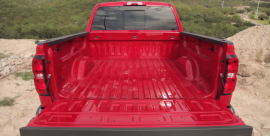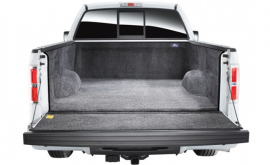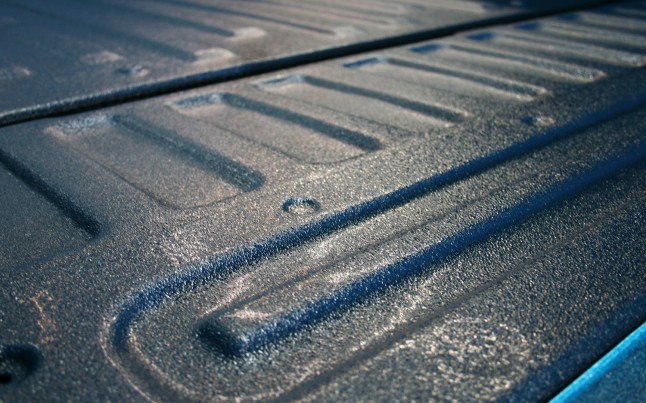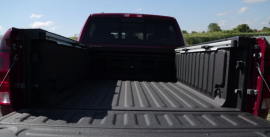A pickup truck without a bedliner feels like a foot without a sock or a cell phone without a case. For quite some time, a simple sheet of plywood was the unofficial bed protector of America, but modern day pickup trucks are almost all outfitted with the latest and greatest bedliners made from a variety of materials. So which one is best for you?
What are the Options?

A bed without a liner
There are many kinds of bedliners, ranging from rubber mats to outdoor carpet material, available from aftermarket manufacturers, but just two types are available directly from manufacturers: either a spray-in liner or a drop-in liner. These two have proven to be the most affective at the job of protecting the bed, although each has its own sets of advantages and disadvantages.
Pros and Cons
Drop-in liners are the cheaper option of the two. A drop-in bedliner is essentially a form fitted plastic sheet that is literally “dropped in” to the bed and then fastened with bolts. For the most part, a drop-in bedliner ordered directly from the factory will protect the entire bed, although there are other versions with that will only protect the floor. There is also a choice of under the rail or over the rail, which denotes whether or not the liner will wrap over or under the steel lip at the top of the bed.
So why would you want a drop-in liner? There are a variety of reasons and it comes down to how your truck is used. The hard plastic used to form this type of bedliner allows things to be slid across it easily, making loading large objects, especially with a forklift, much simpler. Besides that a drop-in bedliner can be replaced easily with little prep work and it can also hide current damage.
SEE ALSO: Why Your Pickup Truck’s Tow Rating is BS

Ford’s BedRug option
However, drop-in liners are generally regarded as less rugged than spray-in liners for a few reasons. Water can easily be trapped between the plastic and steel, which will cause your bed to rust. They can also break and become loose over time. This is aggravated because it is relatively easy to snag the edge of a drop-in liner and pull part of it up, which is almost impossible to fix. To top it off, the fact that things slide on these liners can also make them a pain when transporting large objects in the bed.
Spray-in liners address many of those issues right off the bat. First off, spay-in liners are permanent. They won’t shift, break or possibly fall out because the polyurethane elastomer used adheres directly to the bed. This offers protection for the bed as well, blocking water, dirt and damage that could potentially lead to rust.
Different types of spray-in liners can be purchased, but the majority use a gritty substance with a texture similar to sand paper that prevents things from sliding around. It’s nice to have grip in your bed to stop things from sliding. From a purely cosmetic stand point, a spray-in liner is also more aesthetically pleasing, as drop-in liner tend to start to look old and haggard.
Of course, there are some downsides associated with spay-in liners. First, this type of bed treatment will cost more than a drop-in liner. You can do it yourself to save some money, but having it installed at the factory is your safest bet. That is because spraying in a liner takes some prep work. You have to clean the bed thoroughly and then sand down the entire surface to make it course, which will help the liner adhere to the steel.
Finally, the fact that nothing likes to slide on a spray-in liner means that loading heavy items, especially those on pallets, will be a much bigger hassles because you can’t simply slide them into the bed.
So Who Sells What?

Spray-In liner close up
Each one of the five manufacturers that make half-ton pickups offers some sort of liner to protect your bed.
From the factory, the Toyota Tundra is only available with a drop-in bedliner and prices depend on the size of the bed. A short box costs $365 while a long box bedliner will cost $395. Aftermarket and dealer-installed options are also available, but pricing will vary from store to store.
SEE ALSO: Top 10 Pickup Truck Innovations
Ford offers plenty to choose from. Straight from the factory, it’s the only company that offers both a spray-in liner ($475) and a drop-in liner ($350). However, it offers a huge selection through its accessory program including drop-in rubber mats that sell for $140 and even a type of carpet that goes for $425.
GM will only sell you a spray-in bedliner from the factory for $475, while a drop-in liner has to be installed by a dealer. Unlike other dealer-installed options, GM sets the price at $385 for a dealer-installed drop-in liner. A rubber bed mat is also available through GM’s accessories program.

RAM’s factory spray-in liner
Chrysler also offers a spray-in liner straight from the factory for $475, which can also be applied inside the optional Ram boxes. If you are looking for a Ram with a drop-in, the brand’s in-house aftermarket outfit Mopar can help you out. An under-the-rail bedliner goes for $347, and it can also be used in the truck’s Ram boxes as well.
Finally, for those interested in a Nissan Titan, getting a bedliner is a little trickier. Every other manufacturer will allow you to order the bedliner as a stand alone option, while Nissan will only apply a factory spray-in liner once you purchase the SV Utility Package which costs $1,090 and comes with other bed options including bedliners, lockable bedside storage compartments and a bed-mounted 120-volt outlet.
For drop-in liners, Nissan accessories offer a $302 option for short bed trucks and $324 for long beds, though that excludes the dealer charges for installation.
THE VERDICT
Like any purchase in the automotive world, the type of bedliner you buy has to be based on the specific uses you have in mind. If you need a liner that will allow things to be slid across it, won’t break the bank and is easily replaceable, a drop-in belongs in the back of your pickup.
But if longevity and overall protection are key and price is not an issue, a spray-in bedliner will stick with you for the life of your truck.
There is no one-size-fits-all option. Each has its own set of advantages and disadvantages, but one thing is certain: take care of your truck bed, and it will take care of you.








